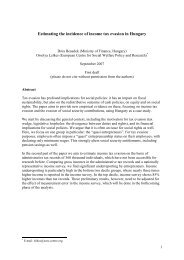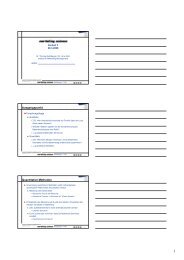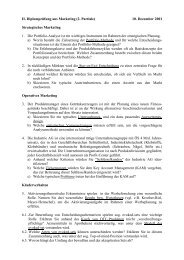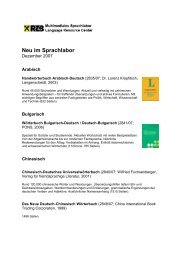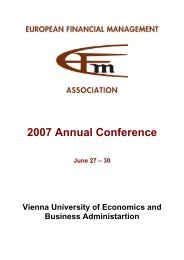Fund liquidation, self-selection and look-ahead bias in the hedge ...
Fund liquidation, self-selection and look-ahead bias in the hedge ...
Fund liquidation, self-selection and look-ahead bias in the hedge ...
You also want an ePaper? Increase the reach of your titles
YUMPU automatically turns print PDFs into web optimized ePapers that Google loves.
over <strong>the</strong> entire sample period, mov<strong>in</strong>g forward by one quarter at <strong>the</strong><br />
peated<br />
<strong>and</strong> adjust<strong>in</strong>g <strong>the</strong> sample by <strong>in</strong>clud<strong>in</strong>g <strong>the</strong> funds that have a sufficiently<br />
time<br />
return history. <strong>Fund</strong>-of-funds are excluded to avoid double count<strong>in</strong>g.<br />
long<br />
avoid backfill<strong>in</strong>g <strong>bias</strong>, returns are only used <strong>in</strong> this exercise if <strong>the</strong> fund<br />
To<br />
hasahistoryofatleastfourquarters.<br />
of all, <strong>in</strong> order to prevent spurious performance persistence patterns<br />
First<br />
are due to <strong>look</strong>-<strong>ahead</strong> <strong>bias</strong> (see, e.g. Carpenter <strong>and</strong> Lynch, 1999),<br />
that<br />
apply <strong>the</strong> correction method as <strong>in</strong>troduced by ter Horst, Nijman <strong>and</strong><br />
we<br />
we repeat <strong>the</strong> analysis of Baquero, ter Horst<br />
Basically,<br />
Verbeek (2005) by multiply<strong>in</strong>g <strong>the</strong> performance measure (e.g. average<br />
<strong>and</strong><br />
over <strong>the</strong> rank<strong>in</strong>g period) with a estimated weight factor ŵ 1,it which is<br />
return<br />
ratio of an unconditional non-<strong>liquidation</strong> probability <strong>and</strong> a conditional<br />
<strong>the</strong><br />
probability. The latter probability can be obta<strong>in</strong>ed from our<br />
non-<strong>liquidation</strong><br />
<strong>liquidation</strong> process reported <strong>in</strong> Section 3. Let<br />
estimated<br />
( ∑ 6<br />
1 + = ˆγ 1j r i,t−j<br />
+ x ′ )<br />
it<br />
ˆβ 1 ˆα Φ<br />
j=1<br />
<strong>the</strong> estimated (conditional) probability that fund i does not liquidate<br />
denote<br />
period t, where Φ denotes <strong>the</strong> st<strong>and</strong>ard normal distribution function.<br />
<strong>in</strong><br />
Then <strong>the</strong> denom<strong>in</strong>ator of w 1,it<br />
∏t+s+1<br />
τ =t+1 ˆp iτ<br />
, (12)<br />
s = 4(quarters) <strong>in</strong> case of annual persistence. The unconditional<br />
where<br />
is equal to <strong>the</strong> ratio of funds that were not liquidated dur<strong>in</strong>g<br />
probability<br />
rank<strong>in</strong>g period <strong>and</strong> <strong>the</strong> number of funds present at <strong>the</strong> beg<strong>in</strong>n<strong>in</strong>g of <strong>the</strong><br />
<strong>the</strong><br />
For <strong>the</strong> evaluation period, we compute average returns with<strong>in</strong> each<br />
period.<br />
aga<strong>in</strong> weighted by ŵ 1,it where <strong>the</strong> numerator now corresponds to <strong>the</strong><br />
decile,<br />
of survived funds <strong>in</strong> <strong>the</strong> correspond<strong>in</strong>g decile.<br />
proportion<br />
we correct for <strong>self</strong>-<strong>selection</strong> <strong>bias</strong> by multiply<strong>in</strong>g <strong>the</strong> performance<br />
Next,<br />
with a second weight factor w 2,it . Thisfactoris<strong>the</strong>ratioof<strong>the</strong><br />
measure<br />
probability of non-<strong>self</strong>-<strong>selection</strong> (conditional upon not be<strong>in</strong>g liquidated),<br />
conditional<br />
<strong>and</strong> an unconditional non-<strong>self</strong>-<strong>selection</strong> probability (conditional<br />
not be<strong>in</strong>g liquidated). The conditional probability can be obta<strong>in</strong>ed<br />
upon<br />
<strong>the</strong> estimated <strong>self</strong>-<strong>selection</strong> process of Section 3. The unconditional<br />
from<br />
Verbeek (2001).<br />
ˆp it<br />
= ˆP {L it<br />
=1|r i,t−1,r i,t−2, ..., x it<br />
} =<br />
(11)<br />
<strong>in</strong>(9)isestimatedas<br />
18



